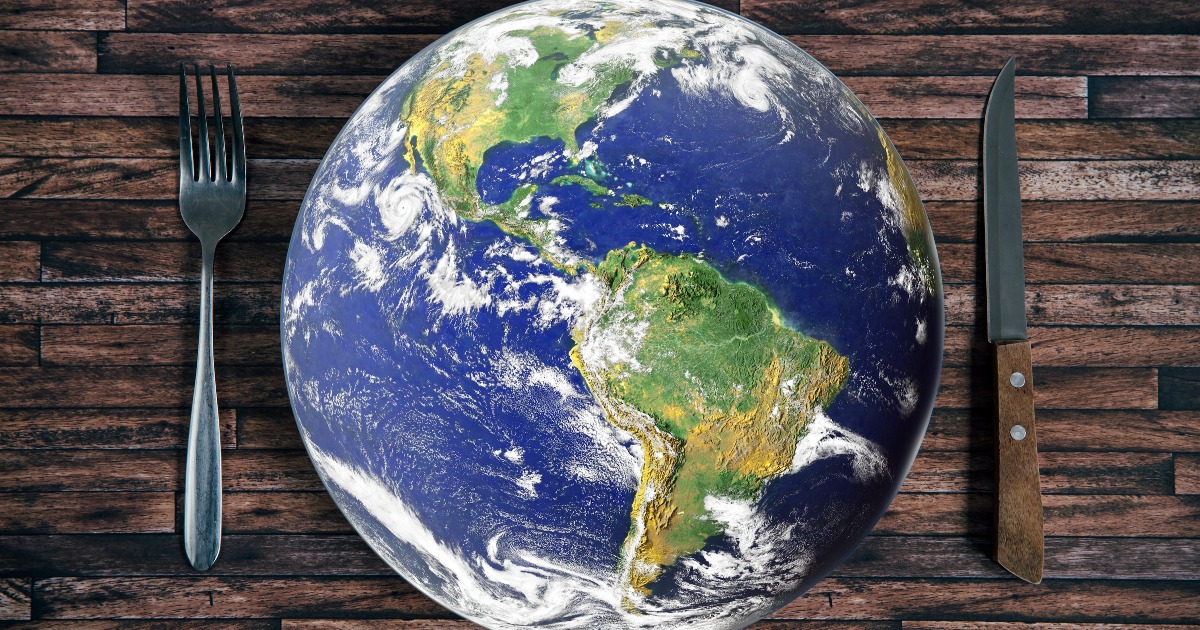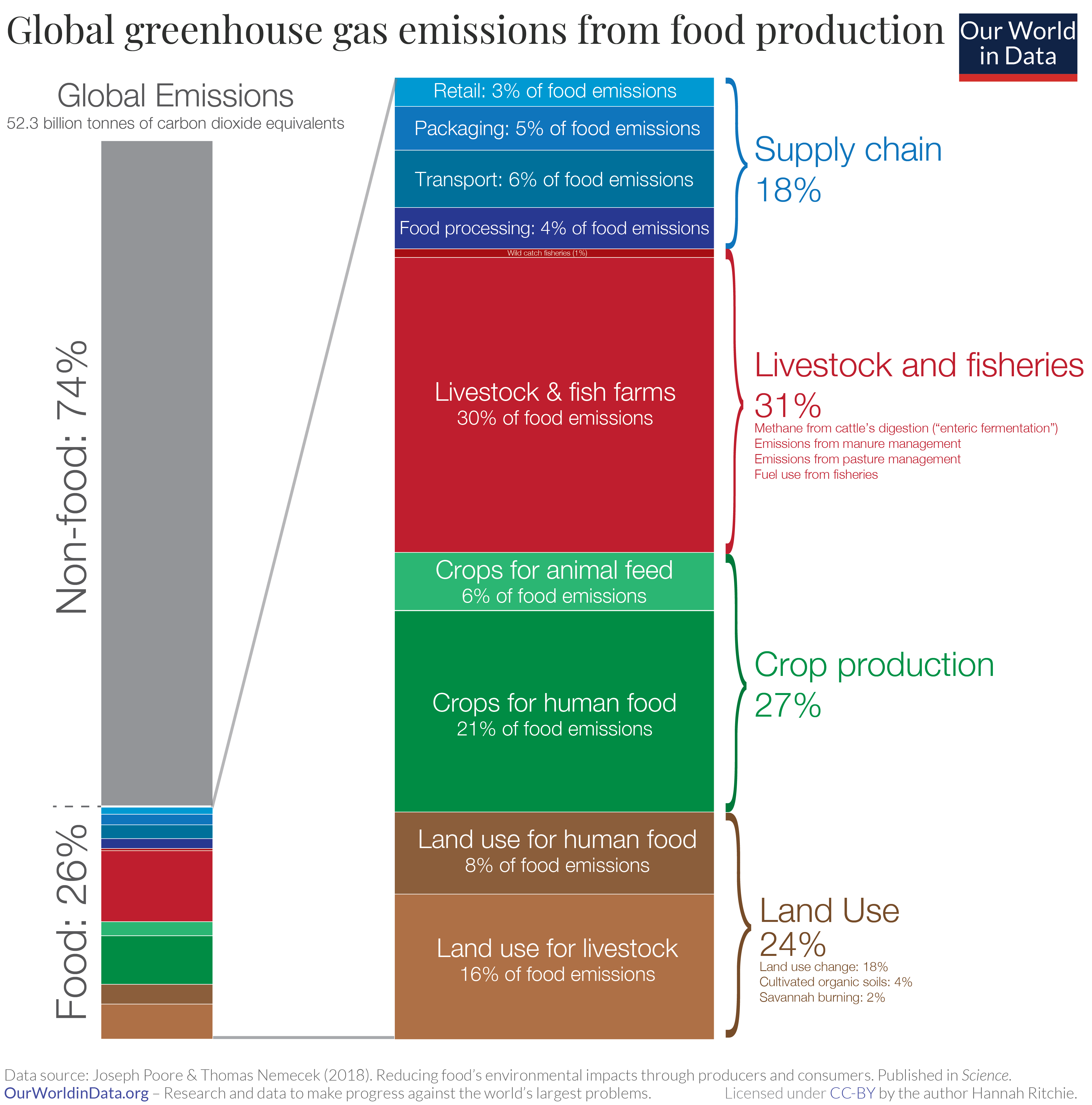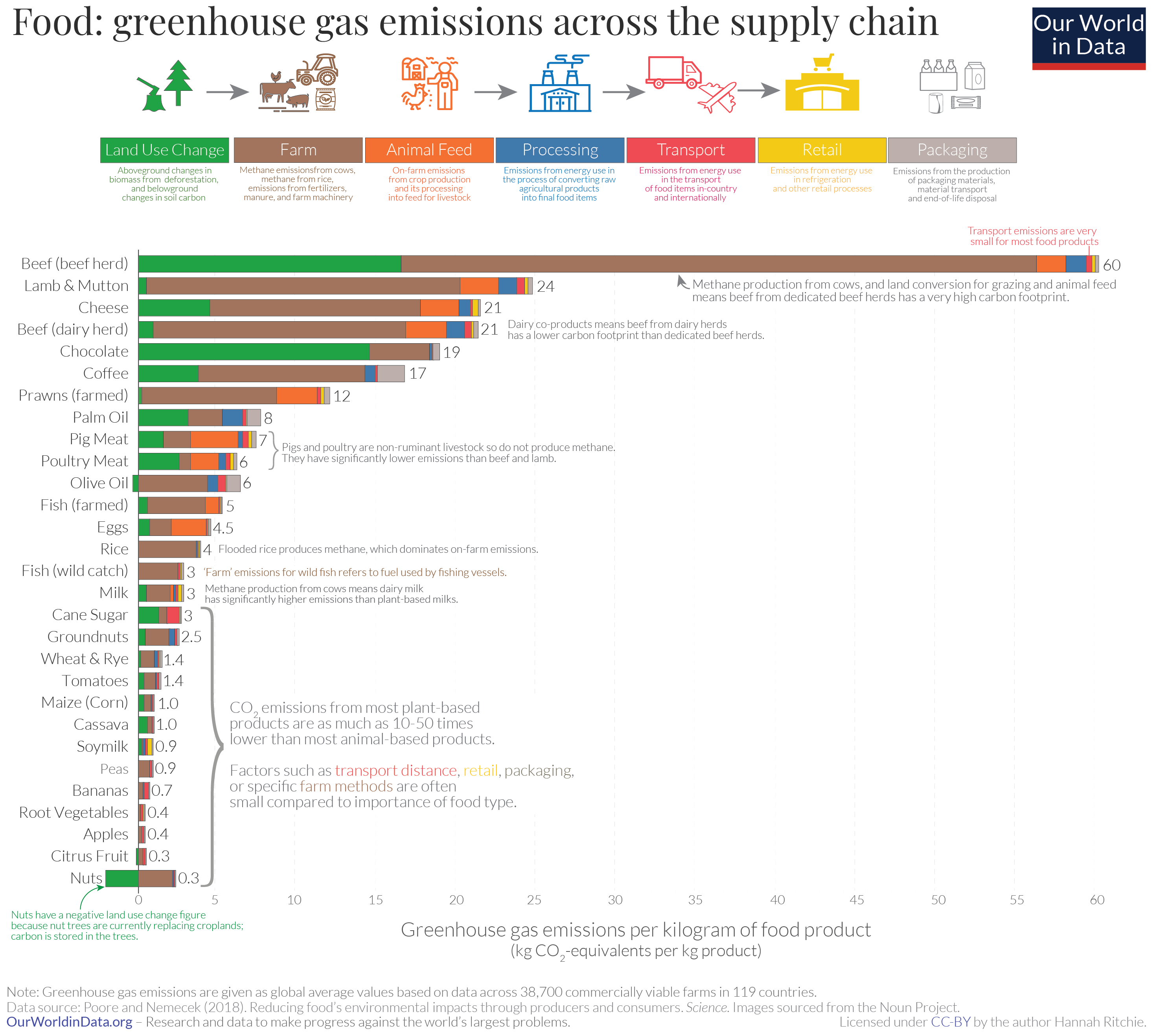Which decisions make the biggest real difference to your diet-related carbon footprint? Do you need to count your food miles as well as your calories? Do you need to go vegan?
This guide provides an in-depth analysis of the greenhouse gas emissions of food and provides some tips for reducing your dietary greenhouse gas emissions.

Your diet doesn't only drive how healthy you feel, it is also one of the biggest drivers of climate change, contributing around a quarter of global greenhouse gas emissions.
To get a better understanding of the carbon footprint of food let's firstly break down the main sources:
- livestock and fish production is the largest source at 31% of overall food emissions mostly from 'enteric fermentation' (cow / lamb belching) (19%), land management (8%), manure (4%) and fuel use (1%)
- crop production is the second largest source at 27% of overall food emissions including the various chemical and mechanical processes to grow food for people (21%) and livestock (6%)
- land use change is the third major source at 24% of overall food emissions which refers to the clearing of forests and other ecosystems to be replaced by livestock grazing (16%) and farms (8%).
- supply chain is the smallest source of emissions at 18% of overall food emissions which includes food processing (4%), food packaging (5%), food transport (6%) and food retail (3%)

The data helps dispel a widely held belief that food miles are the biggest factor in the carbon footprint of food. On the face of it, it makes sense that the further food travels from the farm to your plate, the larger its carbon footprint, but in reality transport emissions represent only 6% of overall food-related emissions. This conclusion holds across almost all food types as shown below.

Therefore the most significant factor in the carbon footprint of food is the production and land use changes associated with the food itself, rather than the transport food miles and other supply chain emissions.
So let's compare the emissions of different types of food. The chart above isn't the best way to compare different foods because one kilogram of coffee provides quite a different dietary role to one kilogram of rice. To compare foods fairly we instead express them in terms of equivalent dietary value.
The following chart shows the greenhouse emissions of various foods compared in a more balanced way in terms of equivalent dietary protein. We've intentionally excluded foods without significant protein like tomatoes to avoid strange outliers.
The data demonstrates that meat and dairy products emit 3-50 times the greenhouse emissions of equivalent plant-based protein sources, making the amount of meat and dairy in your diet easily the biggest factor in the carbon footprint of your diet.
Digging deeper, the data shows that the type of meat you prefer eating is also a significant factor. Some meat products have a relatively lower carbon footprint including poultry, fish and pork products at around 6-7kg CO2e/100g protein or around 3 to 6 times the greenhouse emissions of an equivalent amount of vegetable protein. The most intensive meat product is beef at 50kg CO2e / 100g protein or around 25-50 times vegetable protein, followed by lamb at 20kg CO2e / 100g protein or 10-20 times vegetable protein.
The same conclusions can be drawn if we instead look at the emissions of various foods per unit of dietary energy as shown below.
Therefore the single most impactful action you can take to reduce your dietary carbon footprint is to reduce your meat and dairy consumption. When you do eat meat we recommend you avoid eating beef or lamb and instead eat ethically and sustainably farmed poultry, fish or pork products.
But if we reduced our meat in our diet, wouldn't we need to eat loads of tofu and lentils to replace all the protein?

The average diet in Europe, North America or Australia includes almost double the protein required for a healthy diet. In fact, most people in these countries eat almost their entire dietary protein requirement from vegetable sources already. The remaining protein requirement would be adequately covered by a small lean chicken breast each day. The rest of the dietary protein we consume is effectively food waste and passes through our bodies.
So do we all need to go vegetarian or vegan to have an impact?
The World Resources Institute analysed the greenhouse gas reduction of a range of dietary changes:
- a Mediterranean diet
- shift 1/3 of beef to poultry or pork
- shift 1/3 of beef to legumes
- reduce beef consumption by 70%
- reduce animal protein consumption by half
- go vegetarian
The relative greenhouse gas reduction is summarised in the following chart.

Although vegetarian and vegan diets can represent a healthy and low carbon food choice, the analysis suggests you can cut the carbon footprint of your food by almost as much (nearly half!) by simply reducing the amount of meat you eat to match healthy dietary guidelines (roughly a small portion of chicken once each day).
A final important factor in the carbon footprint of your food is the amount of food you buy but never eat. Roughly a third of all food is never eaten, most of which is disposed to landfill. In landfill this wasted food converts to methane, which is a powerful greenhouse gas. If food waste is instead composted it is transformed back into carbon dioxide which is significantly less impactful to the climate. We therefore recommend avoiding food waste where possible and composting any remaining food waste.
Next steps
If this all seems confusing then don't worry; we have created an app to help you calculate and reduce your carbon footprint. You begin by answering a targeted set of questions about your household. We then provide a personalised benchmark and breakdown of your carbon footprint. We then help you reduce your carbon footprint by providing a tailored plan and ongoing support to help you get your carbon footprint under control. The service is free and only takes around 15-20 minutes.